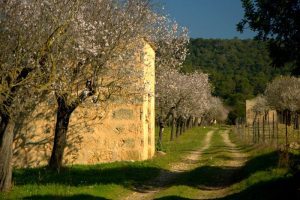La Isla de la Calma
Origin
Do you know the origin of this evocative phrase and how it came to symbolize Mallorca so profoundly?
In Spain, particularly in the Balearic Islands, the phrase “La Isla de la Calma” has long been synonymous with Mallorca, evoking images of serene landscapes and a slower pace of life. This concept, popularized by the Catalan artist Santiago Rusiñol in his 1913 work L’illa de la calma, encapsulates the island’s enduring appeal as a refuge from the hustle and bustle of modern life.
Mallorca, often referred to as the jewel of the Mediterranean, has captivated travelers and artists for centuries. Yet, few have captured its essence as deeply and poetically. This book not only testifies to Mallorca’s natural and cultural charm but also presents an intimate vision of the island as a refuge of peace and tranquility in an increasingly hectic world.
Rusiñol’s Vision of Calmness
Rusiñol, known for his wanderlust and keen artistic sensitivity, arrived in Mallorca at a time when modernity was beginning to transform life across Europe. Cities were becoming industrialized, and life was speeding up, bringing with it a sense of haste and anxiety that affected many, including Rusiñol himself. It was within this context that the artist found Mallorca to be the perfect antidote to urban life—a place where time seemed to stand still, and calmness reigned in every aspect of life.
In the prologue of his work, Rusiñol describes Mallorca with words that resonate deeply with those seeking an escape from modern life. He begins with:
“Dear reader: if you suffer from neurasthenia or think you might, which is already suffering; if you are overwhelmed by the noise of civilization, follow me to an island I will tell you about, an island where calm always prevails, where men are never in a hurry, where women never grow old, where words are never wasted, where the sun lingers longer, and the moon walks more slowly, infected by laziness.”
Santiago Rusiñol i Prats, L’Illa de la calma, 1913
This opening paragraph encapsulates Rusiñol’s idyllic vision of Mallorca. His reference to “neurasthenia,” a nervous condition commonly associated with the stress of modern life, and his invitation to escape to an island where “calm always prevails” and “men are never in a hurry” underscore Mallorca’s image as a sanctuary for those burdened by the demands of civilization.
The Timeless Influence of Mallorca
The calmness Rusiñol speaks of is not merely an absence of noise or activity but a deeper quality that permeates all aspects of life on the island. It manifests in the attitude of its inhabitants, in the unhurried pace of nature, and in the way time seems to stretch, allowing visitors to immerse themselves in a state of relaxation and contemplation—a stark contrast to the hustle and bustle of European cities.
Rusiñol attributes this calmness not only to the island itself but also to its people. By claiming that “men are never in a hurry” and “women never grow old,” Rusiñol suggests that the tranquility of Mallorca has an almost timeless effect on its residents. This reflects an idealization of rural and traditional life, where modern concerns have yet to fully penetrate. For Rusiñol, the people of Mallorca seem to live in harmony with the island’s natural rhythm, free from the urgency and anxiety that characterize modern life.
Moreover, Rusiñol emphasizes that in Mallorca, “words are never wasted.” This observation can be seen as a reflection on the simplicity and authenticity of communication on the island, where words are few but meaningful, and where silence holds intrinsic value. In a world where noise and overcommunication are ubiquitous, this appreciation for silence and measured speech is undoubtedly part of Mallorca’s appeal as a place for retreat and reflection.
Modern Challenges to the Island’s Serenity
However, Rusiñol’s idealized vision of Mallorca raises questions about the balance between preserving this calmness and the inevitable modernization that accompanies tourism development. Since the publication of L’illa de la calma, Mallorca has seen significant growth in its tourist infrastructure, attracting millions of visitors each year. This influx has brought challenges, such as the pressure on natural resources and the need to maintain the island’s cultural authenticity.

Despite these challenges, the essence of Mallorca as “the island of calm” remains intact. The island has managed to adapt to the demands of modern tourism without losing the charm that Rusiñol so eloquently captured in his work. Many areas of Mallorca, especially those away from the main tourist zones, still retain the unhurried pace and tranquility that fascinated Rusiñol. Moreover, the growing focus on sustainable tourism and wellness reflects a collective desire to maintain and protect the serenity that makes Mallorca so special.
Conclusion: A Legacy of Calm
Santiago Rusiñol’s description of Mallorca as “the island of calm” is not just a poetic observation but an invitation to rediscover the value of tranquility in an increasingly frantic world. Through his words, Rusiñol reminds us that the true wealth of Mallorca lies not only in its natural beauty but in its ability to offer visitors a pause, a respite from the frenetic pace of modern life. Today, more than a century after the publication of L’illa de la calma, Mallorca continues to be that serene refuge Rusiñol described—a place where time slows down and calmness reigns supreme.
If you find yourself yearning for that sense of relaxation and calm that Rusiñol so beautifully depicted, consider experiencing Mallorca through the lens of luxury and tranquility. Contact le Luxure to plan your perfect escape to this timeless island, where the serene beauty of Mallorca awaits you.





